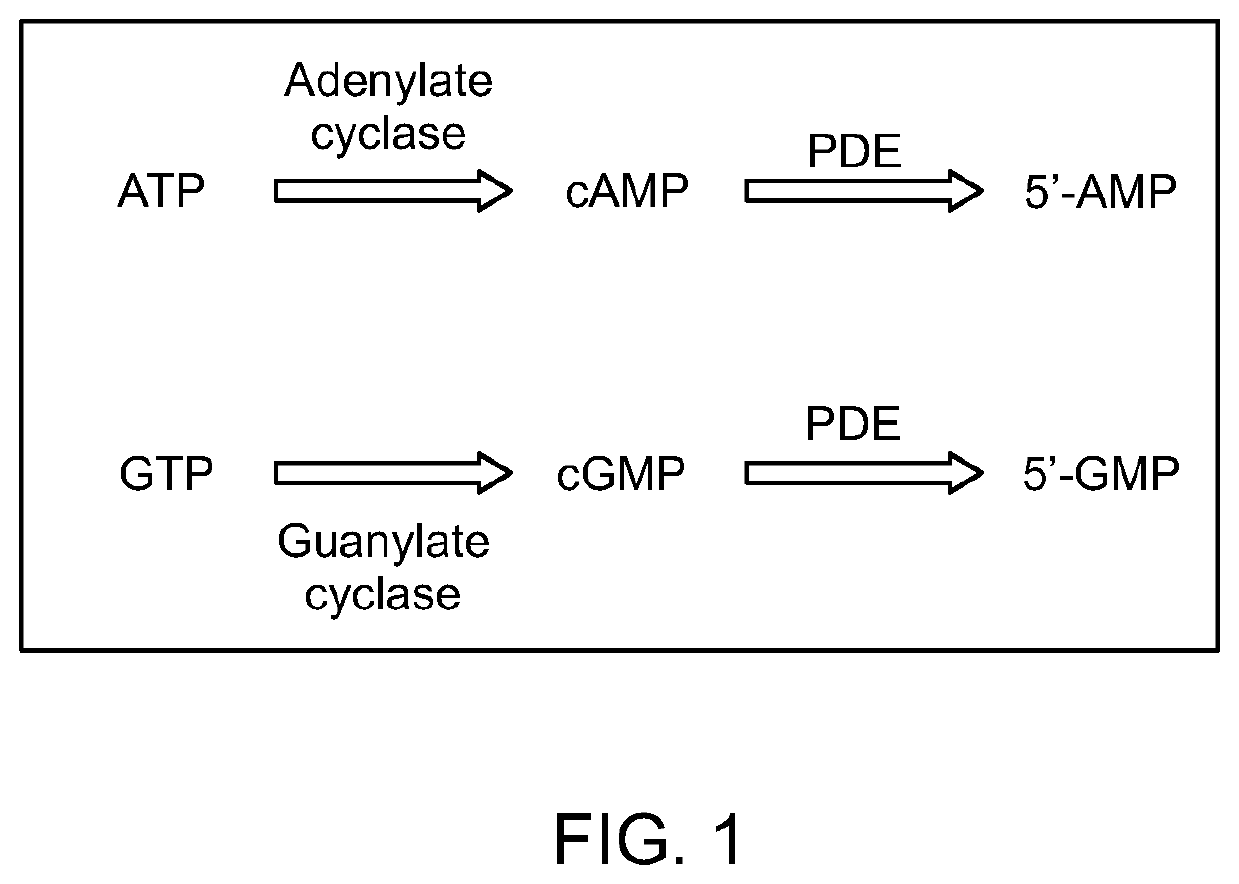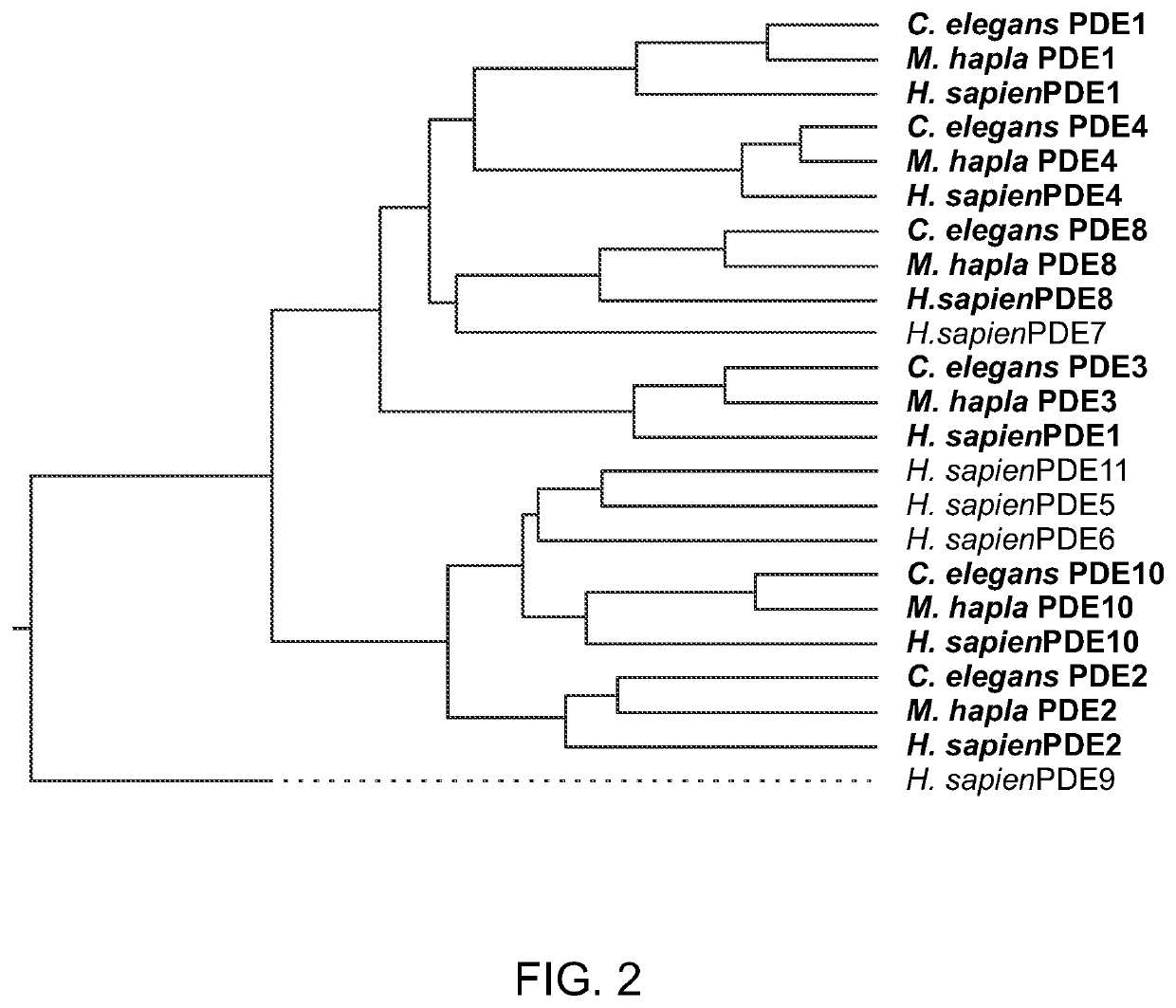Methods of identification and use of nematicide compounds
a nematode and compound technology, applied in the field of nematicide compositions, can solve the problems of crop damage of $80-100 billion dollars annually, reduced agricultural productivity, and traditional approaches that have only partially succeeded in reducing nematode damage to crops, so as to reduce the activity of a phytoparasitic nematode, and improve the effect of inhibition
- Summary
- Abstract
- Description
- Claims
- Application Information
AI Technical Summary
Benefits of technology
Problems solved by technology
Method used
Image
Examples
example 1
[0121]Basic Local Alignment Search Tool (BLAST) searches were performed to determine whether putative Class I, II, and III PDEs were present in plants. Use of query sequences from vertebrate and invertebrate Class I PDEs, as well as a Class II (Vibrio cholera) and a Class III (Dictyostelum Discoidem) PDE catalytic domain sequences, did not identify any PDE sequences in the completed genomes of Arabidopsis thaliana and Oryza sativa. This finding supports a conclusion that introduction of PDE inhibitor compounds as nematicides would likely have minimal or no adverse effects on agricultural crops that are hosts for phytoparasitic nematodes.
Phylogenetic Tree for Vertebrate and Nematode PDEs.
[0122]Sequences from each vertebrate PDE family along with nematode PDE sequences from 4 Caenorhabditis species and from M. hapla were aligned and a tree generated (see FIG. 2). For simplicity, only human sequences, M. hapla sequences, and C. elegans sequences are represented in the figure. A listing...
example 2
[0132]Preliminary results suggest that observed differences between nematode and vertebrate PDE catalytic domain amino acid sequences may result in altered sensitivity of nematode PDEs toward selective PDE inhibitors. The pharmacological properties of C. elegans and M. hapla PDE catalytic domains are characterized with a set of family-selective PDE inhibitor compounds. These experiments may identify family-specific PDE inhibitor compounds useful for evaluating the physiological consequences of disrupting cyclic nucleotide metabolism in the free-living nematode C. elegans and the phytoparasitic nematode M. hapla.
Methods to Sub-clone and Express the Catalytic Domains of Selected PDEs from C. elegans and M. hapla.
[0133]It is known that catalytic domains from most vertebrate PDE families can be expressed as recombinant proteins. Experiments are performed to express nematode PDE catalytic domains in a bacterial expression system in a catalytically active form. The open reading frames o...
example 3
Evaluation of the Ability of PDE Inhibitors to Prevent Hatching of C. elegans Eggs
[0137]To assess disruption of activities such as developmental progression leading to egg hatching in nematodes, C. elegans eggs are exposed to PDE inhibitors. The nematode eggs are exposed to a range of concentrations of family-specific PDE inhibitors, and inhibitors that prevent egg hatching are identified. Results of the testing with various PDE inhibitors are shown in FIG. 6.
Assays to Determine Efficacy of PDE Inhibitor Compound in Disrupting Chemosensation Pathways in Larvae and Adult Stage Nematodes Such as C. elegans or a Phytoparasitic Nematode.
[0138]Experiments are performed to identify whether disrupting cyclic nucleotide signaling pathways involved in locomotion and / or chemotaxis with PDE inhibitors results in paralysis, uncoordinated movement, and / or inability to respond to chemical gradients. Using tracking assays, PDE inhibitor compounds that are effective in disrupting chemotaxis in C. e...
PUM
| Property | Measurement | Unit |
|---|---|---|
| time | aaaaa | aaaaa |
| time- | aaaaa | aaaaa |
| resistance | aaaaa | aaaaa |
Abstract
Description
Claims
Application Information
 Login to View More
Login to View More - R&D
- Intellectual Property
- Life Sciences
- Materials
- Tech Scout
- Unparalleled Data Quality
- Higher Quality Content
- 60% Fewer Hallucinations
Browse by: Latest US Patents, China's latest patents, Technical Efficacy Thesaurus, Application Domain, Technology Topic, Popular Technical Reports.
© 2025 PatSnap. All rights reserved.Legal|Privacy policy|Modern Slavery Act Transparency Statement|Sitemap|About US| Contact US: help@patsnap.com



